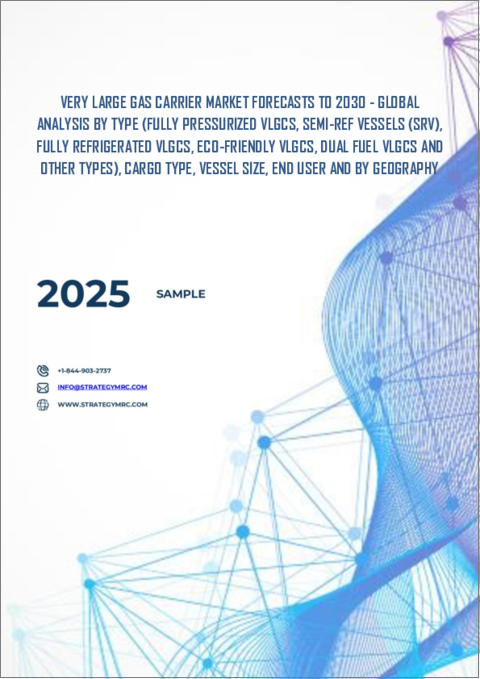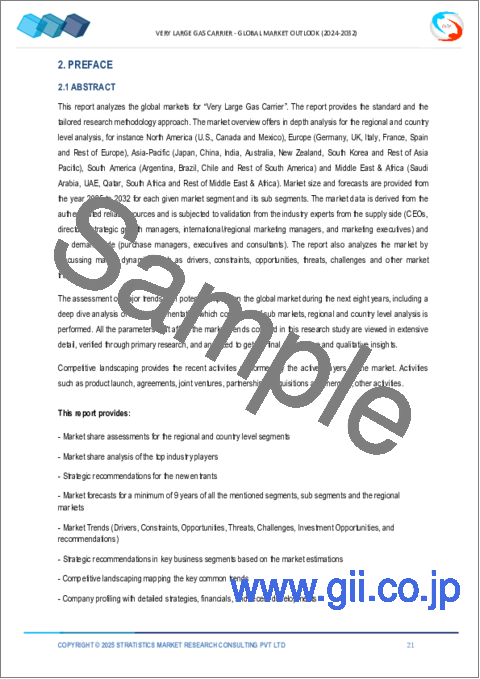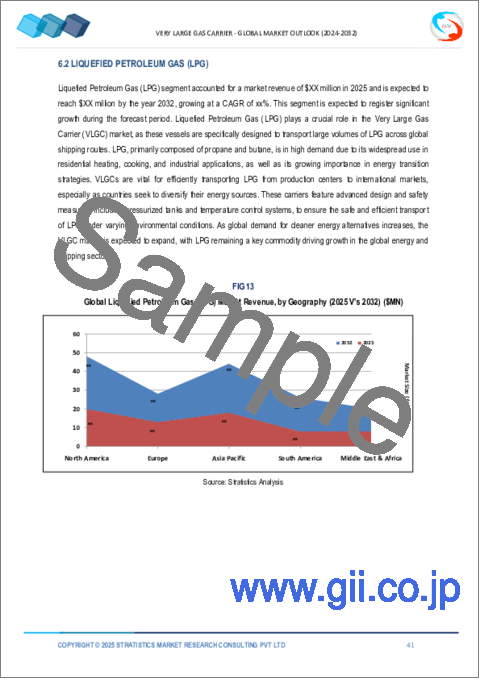|
|
市場調査レポート
商品コード
1476333
超大型ガスキャリア市場の2030年までの予測: タイプ別、貨物タイプ別、船舶サイズ別、エンドユーザー別、地域別の世界分析Very Large Gas Carrier Market Forecasts to 2030 - Global Analysis By Type (Fully Pressurized VLGCs, Semi-Ref Vessels, Fully Refrigerated VLGCs, Eco-Friendly VLGCs, Dual Fuel VLGCs and Other Types), Cargo Type, Vessel Size, End User and By Geography |
||||||
カスタマイズ可能
|
|||||||
| 超大型ガスキャリア市場の2030年までの予測: タイプ別、貨物タイプ別、船舶サイズ別、エンドユーザー別、地域別の世界分析 |
|
出版日: 2024年05月05日
発行: Stratistics Market Research Consulting
ページ情報: 英文 200+ Pages
納期: 2~3営業日
|
- 全表示
- 概要
- 図表
- 目次
Stratistics MRCによると、世界の超大型ガスキャリア市場は2023年に73億4,000万米ドルを占め、予測期間中のCAGRは9.4%で成長し、2030年には96億8,000万米ドルに達する見込みです。
超大型ガスキャリアは、液化石油ガス(LPG)を大量に輸送するために設計された特殊船舶です。VLGCは世界のエネルギー貿易において重要な役割を果たしており、LPGの生産拠点から世界中の消費市場への輸送を促進しています。VLGCは、可燃性の高い貨物の輸送に伴う特有の課題に対処するため、高度な安全機能を備えています。VLGCは、特に天然ガス・インフラへのアクセスが制限されている地域において、クリーン・エネルギー源に対する需要の増大に対応するために不可欠です。
オブザーバトリー・オブ・エコノミック・コンプリシティ(OEC)によると、北米は2021年に400億米ドルとなる世界のLPG輸出の15.0%を占めました。
世界のエネルギー需要
VLGCは、大量のLNGを長距離輸送し、世界中の地域のエネルギー需要を満たすために不可欠です。工業化と都市化が拡大し、よりクリーンな燃料への移行が進むにつれて、LPGとLNGの需要が高まっています。VLGCは、これらのガスを長距離にわたって効率的に輸送し、世界の多様な市場に対応する上で重要な役割を果たしています。エネルギー消費パターンが進化し、ガスの需要が急増するにつれ、VLGC市場はこれらの増大するニーズに対応するために拡大し、世界のエネルギー情勢において極めて重要な役割を担っています。
規制コンプライアンス
VLGCの規制順守には、国際海事機関(IMO)などの国際機関が定めた厳しい安全、環境、運航基準が含まれます。これらの規制は、設備のアップグレード、乗組員の訓練、コンプライアンス監査など、VLGCオペレーターに高いコストを課しています。さらに、コンプライアンス違反は罰則や風評被害のリスクとなり、さらなるプレッシャーとなります。その結果、コンプライアンス負担は運航経費を膨らませ、収益性に影響を与え、市場の成長を妨げることになります。
シェールガス生産の増加
超大型ガスキャリアは、LNGの世界の流通を促進する重要な資産となっています。特に米国などの地域でシェールガスの採掘量が増加するにつれて、世界中のさまざまな市場にLNGを輸送するためのVLGCの必要性が高まっています。このようなシェールガス生産の拡大がVLGC市場の成長を促し、LNG輸送の需要増に効率的かつ持続的に対応するための船舶建造、物流、関連サービスへの投資を促進しています。
過剰設備への懸念
VLGCの過剰船腹は、船腹数が市場の需要を上回った場合に発生し、船会社の運賃と収益性の低下につながります。この余剰船腹は、新造船の流入と廃船率の低迷によって生じ、市場圧力を悪化させる。その結果、船社間の競合が激化し、傭船料が下落し、船舶の稼働率が低下し、運航会社の財政が逼迫します。その結果、海運会社は市場が飽和状態にある中で、持続可能な事業と収益性を維持するという課題に直面しています。
COVID-19の影響
COVID-19の流行はVLGC市場に大きな影響を与え、需給の変動につながった。国際貿易の制限と産業活動の低下により、VLGCの主要貨物であるLPGの需要が減退しました。港湾作業の遅れや乗組員のローテーションの混乱は、船舶運航会社の課題をさらに悪化させました。しかし、世界経済の緩やかな回復と貿易活動の再開は、パンデミック情勢の進展や海上貿易に影響を及ぼす規制の変更により不確実性が残るもの、一定の緩和をもたらしました。
予測期間中、デュアル燃料VLGCセグメントが最大となる見込み
デュアルフューエルVLGCセグメントは有利な成長を遂げると推定されます。デュアル燃料VLGCは、柔軟性と環境上の利点を提供する従来の海洋燃料で走行するように装備された船舶です。これらの船舶は、デュアルフューエルエンジンやLNGと従来の燃料の両方を燃焼可能なエンジンなど、先進的なエンジン技術を活用しており、オペレーターは、よりクリーンな海上輸送への移行に貢献しながら、進化する規制要件や市場環境に適応することができます。
予測期間中にCAGRが最も高くなると予想されるのは石油化学企業セグメントです。
石油化学企業セグメントは、予測期間中に最も高いCAGR成長が見込まれます。石油化学企業はVLGCを利用して、世界中の生産施設から流通センターやエンドユーザーまでガスを輸送しています。これらの船舶は効率的で安全な輸送を保証し、石油化学企業が製品の世界の需要を満たすことを可能にします。VLGCは先進技術を搭載し、厳しい安全・環境規制を遵守しているため、石油化学製品のサプライチェーンにおいて不可欠な資産となっています。
最大のシェアを占める地域
アジア太平洋地域は、液化石油ガス(LPG)輸送需要の増加により、予測期間中最大の市場シェアを占めると予測されます。中国、インド、日本などの国々における急速な工業化と都市化がLPGの需要を煽っています。さらに、インドネシアやベトナムなどの新興国もLPG消費の増加に貢献しています。こうした需要の急増は、VLGCへの大規模な投資につながり、大手海運会社はアジア太平洋地域の急成長する市場に対応するため、船隊拡大や技術進歩に注力しています。
CAGRが最も高い地域:
北米は、シェールガス革命によって液化石油ガス(LPG)の国内生産が増加したため、予測期間中に最も高いCAGRを示すと予測されます。米国は、特にアジア市場へのLPGの重要な輸出国として浮上しています。このため、輸送用VLGCの需要が高まっています。さらに、カナダのLPG生産は、地域の輸送ニーズに貢献しています。北米のVLGC市場情勢を形成する上で、規制状況やインフラ整備も重要な役割を担っており、同地域は進化するエネルギー力学に適応し続けています。
無料のカスタマイズサービス
本レポートをご購読のお客様には、以下の無料カスタマイズオプションのいずれかをご利用いただけます:
- 企業プロファイル
- 追加市場プレーヤーの包括的プロファイリング(3社まで)
- 主要企業のSWOT分析(3社まで)
- 地域セグメンテーション
- 顧客の関心に応じた主要国の市場推計・予測・CAGR(注:フィージビリティチェックによる)
- 競合ベンチマーキング
- 製品ポートフォリオ、地理的プレゼンス、戦略的提携に基づく主要企業のベンチマーキング
目次
第1章 エグゼクティブサマリー
第2章 序文
- 概要
- ステークホルダー
- 調査範囲
- 調査手法
- データマイニング
- データ分析
- データ検証
- 調査アプローチ
- 調査情報源
- 1次調査情報源
- 2次調査情報源
- 前提条件
第3章 市場動向分析
- 促進要因
- 抑制要因
- 機会
- 脅威
- エンドユーザー分析
- 新興市場
- COVID-19の影響
第4章 ポーターのファイブフォース分析
- 供給企業の交渉力
- 買い手の交渉力
- 代替品の脅威
- 新規参入業者の脅威
- 競争企業間の敵対関係
第5章 世界の超大型ガスキャリア市場:タイプ別
- 圧力式VLGC
- セミレフ船(SRV)
- フルレフVLGC
- エコフレンドリーVLGC
- デュアル燃料VLGC
- その他のタイプ
第6章 世界の超大型ガスキャリア市場:貨物タイプ別
- 液化石油ガス(LPG)
- アンモニア
- エチレン
- プロピレン
- ブタン
- プロパン
- その他の貨物タイプ
第7章 世界の超大型ガスキャリア市場:船舶サイズ別
- 70,000CBM以下
- 70,000-80,000CBM
- 80,000CBM以上
第8章 世界の超大型ガスキャリア市場:エンドユーザー別
- LPG生産者
- エネルギー会社
- 石油化学会社
- トレーダーと販売業者
- 小売・商業消費者
- 政府機関
- その他のエンドユーザー
第9章 世界の超大型ガスキャリア市場:地域別
- 北米
- 米国
- カナダ
- メキシコ
- 欧州
- ドイツ
- 英国
- イタリア
- フランス
- スペイン
- その他欧州
- アジア太平洋地域
- 日本
- 中国
- インド
- オーストラリア
- ニュージーランド
- 韓国
- その他アジア太平洋地域
- 南米
- アルゼンチン
- ブラジル
- チリ
- その他南米
- 中東・アフリカ
- サウジアラビア
- アラブ首長国連邦
- カタール
- 南アフリカ
- その他中東とアフリカ
第10章 主な発展
- 契約、パートナーシップ、コラボレーション、合弁事業
- 買収と合併
- 新製品発売
- 事業拡大
- その他の主要戦略
第11章 企業プロファイリング
- Hyundai Samho Heavy Industries
- Mitsui O.S.K. Lines(MOL)
- Avance Gas
- Nippon Yusen Kabushiki Kaisha
- Navigator Gas
- Epic Gas
- Petredec Limited
- Exmar
- StealthGas Inc.
- Norgas Carriers
- APM Terminals
- Dorian LPG
- BW LPG
- Pacific Gas Limited
List of Tables
- Table 1 Global Very Large Gas Carrier Market Outlook, By Region (2021-2030) ($MN)
- Table 2 Global Very Large Gas Carrier Market Outlook, By Type (2021-2030) ($MN)
- Table 3 Global Very Large Gas Carrier Market Outlook, By Fully Pressurized VLGCs (2021-2030) ($MN)
- Table 4 Global Very Large Gas Carrier Market Outlook, By Semi-Ref Vessels (SRV) (2021-2030) ($MN)
- Table 5 Global Very Large Gas Carrier Market Outlook, By Fully Refrigerated VLGCs (2021-2030) ($MN)
- Table 6 Global Very Large Gas Carrier Market Outlook, By Eco-Friendly VLGCs (2021-2030) ($MN)
- Table 7 Global Very Large Gas Carrier Market Outlook, By Dual Fuel VLGCs (2021-2030) ($MN)
- Table 8 Global Very Large Gas Carrier Market Outlook, By Other Types (2021-2030) ($MN)
- Table 9 Global Very Large Gas Carrier Market Outlook, By Cargo Type (2021-2030) ($MN)
- Table 10 Global Very Large Gas Carrier Market Outlook, By Liquefied Petroleum Gas (LPG) (2021-2030) ($MN)
- Table 11 Global Very Large Gas Carrier Market Outlook, By Ammonia (2021-2030) ($MN)
- Table 12 Global Very Large Gas Carrier Market Outlook, By Ethylene (2021-2030) ($MN)
- Table 13 Global Very Large Gas Carrier Market Outlook, By Propylene (2021-2030) ($MN)
- Table 14 Global Very Large Gas Carrier Market Outlook, By Butane (2021-2030) ($MN)
- Table 15 Global Very Large Gas Carrier Market Outlook, By Propane (2021-2030) ($MN)
- Table 16 Global Very Large Gas Carrier Market Outlook, By Other Cargo Types (2021-2030) ($MN)
- Table 17 Global Very Large Gas Carrier Market Outlook, By Vessel Size (2021-2030) ($MN)
- Table 18 Global Very Large Gas Carrier Market Outlook, By Below 70,000 CBM (2021-2030) ($MN)
- Table 19 Global Very Large Gas Carrier Market Outlook, By 70,000 - 80,000 CBM (2021-2030) ($MN)
- Table 20 Global Very Large Gas Carrier Market Outlook, By Above 80,000 CBM (2021-2030) ($MN)
- Table 21 Global Very Large Gas Carrier Market Outlook, By End User (2021-2030) ($MN)
- Table 22 Global Very Large Gas Carrier Market Outlook, By LPG Producers (2021-2030) ($MN)
- Table 23 Global Very Large Gas Carrier Market Outlook, By Energy Companies (2021-2030) ($MN)
- Table 24 Global Very Large Gas Carrier Market Outlook, By Petrochemical Companies (2021-2030) ($MN)
- Table 25 Global Very Large Gas Carrier Market Outlook, By Traders & Distributors (2021-2030) ($MN)
- Table 26 Global Very Large Gas Carrier Market Outlook, By Retail & Commercial Consumers (2021-2030) ($MN)
- Table 27 Global Very Large Gas Carrier Market Outlook, By Government Agencies (2021-2030) ($MN)
- Table 28 Global Very Large Gas Carrier Market Outlook, By Other End Users (2021-2030) ($MN)
Note: Tables for North America, Europe, APAC, South America, and Middle East & Africa Regions are also represented in the same manner as above.
According to Stratistics MRC, the Global Very Large Gas Carrier Market is accounted for $7.34 billion in 2023 and is expected to reach $9.68 billion by 2030 growing at a CAGR of 9.4% during the forecast period. Very large gas carriers are specialized vessels designed for transporting liquefied petroleum gas (LPG) in large quantities. VLGCs play a crucial role in the global energy trade, facilitating the transportation of LPG from production centers to consumption markets worldwide. These ships are equipped with advanced safety features to handle the unique challenges posed by carrying highly flammable cargo. VLGCs are vital for meeting the growing demand for clean energy sources, particularly in regions where access to natural gas infrastructure is limited.
According to the Observatory of Economic Complexity (OEC), North America accounted for a share of 15.0% of the global LPG exports valued at USD 40 billion in 2021.
Market Dynamics:
Driver:
Global energy demand
VLGCs are crucial for transporting large volumes of LNG across vast distances, meeting the energy needs of regions worldwide. With expanding industrialization and urbanization, coupled with the transition towards cleaner fuels, the demand for LPG and LNG rises. VLGCs play a crucial role in efficiently transporting these gases across long distances, catering to diverse markets worldwide. As energy consumption patterns evolve and the demand for gas surges, the VLGC market expands to meet these growing needs, ensuring a pivotal role in the global energy landscape.
Restraint:
Regulatory compliance
Regulatory compliance in VLGCs encompasses stringent safety, environmental, and operational standards set by international bodies like the International Maritime Organization (IMO). These regulations impose high costs on VLGC operators for equipment upgrades, crew training, and compliance audits. Moreover, non-compliance risks penalties and reputational damage, adds further pressure. Consequently, compliance burdens can inflate operational expenses, impacting profitability and hindering market growth.
Opportunity:
Rising shale gas production
Very large gas carriers emerge as vital assets in this landscape, facilitating the global distribution of LNG. As shale gas extraction increases, particularly in regions like the United States, the need for VLGCs escalates to transport LNG to various markets worldwide. This expansion in shale gas production thus propels the growth of the VLGC market, fostering investments in vessel construction, logistics, and related services to meet the rising demand for LNG transportation efficiently and sustainably.
Threat:
Overcapacity concerns
Overcapacity in VLGCs arises when the number of vessels exceeds market demand, leading to reduced freight rates and profitability for shipping companies. This surplus capacity results from an influx of new buildings and slow scrapping rates, exacerbating market pressures. It leads to intensified competition among carriers, lower charter rates, decreased vessel utilization, and financial strain on operators. Consequently, shipping companies face challenges in maintaining sustainable operations and profitability amidst a saturated market.
Covid-19 Impact
The covid-19 pandemic significantly affected the VLGC market, leading to fluctuating demand and supply dynamics. Restrictions on international trade and reduced industrial activities dampened demand for LPG, a key cargo for VLGCs. Delays in port operations and disruptions in crew rotations further compounded challenges for vessel operators. However, the gradual recovery of global economies and the resumption of trade activities provided some relief, although uncertainties persist due to evolving pandemic situations and regulatory changes impacting maritime trade.
The dual fuel VLGCs segment is expected to be the largest during the forecast period
The dual fuel VLGCs segment is estimated to have a lucrative growth. Dual Fuel VLGCs are vessels equipped to run on traditional marine fuels offering flexibility and environmental benefits. These vessels leverage advanced engine technology, such as dual-fuel engines or engines capable of burning both LNG and traditional fuels, allowing operators to adapt to evolving regulatory requirements and market conditions while contributing to the transition towards cleaner maritime transportation.
The petrochemical companies segment is expected to have the highest CAGR during the forecast period
The petrochemical companies segment is anticipated to witness the highest CAGR growth during the forecast period. Petrochemical companies utilize VLGCs to transport these gases from production facilities to distribution centers and end-users worldwide. These vessels ensure efficient and safe transportation, enabling petrochemical companies to meet global demand for their products. VLGCs are equipped with advanced technology and adhere to stringent safety and environmental regulations, making them indispensable assets in the petrochemical supply chain.
Region with largest share:
Asia Pacific is projected to hold the largest market share during the forecast period due to growing demand for liquefied petroleum gas (LPG) transportation. Rapid industrialization and urbanization in countries like China, India, and Japan fuel the demand for LPG. Additionally, emerging economies like Indonesia and Vietnam contribute to the increasing consumption of LPG. This demand surge has led to substantial investments in VLGCs, with major shipping companies focusing on fleet expansions and technological advancements to cater to the burgeoning market in the Asia Pacific region.
Region with highest CAGR:
North America is projected to have the highest CAGR over the forecast period, owing to the shale gas revolution, which has boosted domestic production of liquefied petroleum gas (LPG). The United States has emerged as a significant exporter of LPG, particularly to Asian markets. This has led to a growing demand for VLGCs for transportation purposes. Additionally, Canada's LPG production contributes to regional shipping needs. Regulatory frameworks and infrastructure development also play vital roles in shaping the VLGC market landscape in North America, as the region continues to adapt to evolving energy dynamics.
Key players in the market
Some of the key players profiled in the Very Large Gas Carrier Market include Hyundai Samho Heavy Industries, Mitsui O.S.K. Lines (MOL), Avance Gas, Nippon Yusen Kabushiki Kaisha, Navigator Gas, Epic Gas, Petredec Limited, Exmar, StealthGas Inc., Norgas Carriers, APM Terminals, Dorian LPG, BW LPG and Pacific Gas Limited.
Key Developments:
In April 2024, Hyundai Samho Heavy Industries launched the Taebaek Explorer, a new Very Large Gas Carrier (VLGC). The Taebaek Explorer is the first of two new VLGCs that will be chartered by Trafigura long-term. The Bellavista Explorer has a storage capacity of 90,000 cubic meters and can sail up to 31,700 kilometers at an average speed of 11.2 knots and a maximum speed of 19 knots.
In August 2023, APM Terminals Pipavav commenced operations of very large gas carriers (VLGCs) with the berthing of MT Jag Viraat, a 230-meter-long VLGC vessel owned by Great Eastern Shipping. The VLGC has a 37-meter beam and an arrival draft of 8.2 meters. The port recently revamped its berth to VLGC compliant to accommodate Very Large Gas carriers.
Types Covered:
- Fully Pressurized VLGCs
- Semi-Ref Vessels (SRV)
- Fully Refrigerated VLGCs
- Eco-Friendly VLGCs
- Dual Fuel VLGCs
- Other Types
Cargo Types Covered:
- Liquefied Petroleum Gas (LPG)
- Ammonia
- Ethylene
- Propylene
- Butane
- Propane
- Other Cargo Types
Vessel Sizes Covered:
- Below 70,000 CBM
- 70,000 - 80,000 CBM
- Above 80,000 CBM
End Users Covered:
- LPG Producers
- Energy Companies
- Petrochemical Companies
- Traders & Distributors
- Retail & Commercial Consumers
- Government Agencies
- Other End Users
Regions Covered:
- North America
- US
- Canada
- Mexico
- Europe
- Germany
- UK
- Italy
- France
- Spain
- Rest of Europe
- Asia Pacific
- Japan
- China
- India
- Australia
- New Zealand
- South Korea
- Rest of Asia Pacific
- South America
- Argentina
- Brazil
- Chile
- Rest of South America
- Middle East & Africa
- Saudi Arabia
- UAE
- Qatar
- South Africa
- Rest of Middle East & Africa
What our report offers:
- Market share assessments for the regional and country-level segments
- Strategic recommendations for the new entrants
- Covers Market data for the years 2021, 2022, 2023, 2026, and 2030
- Market Trends (Drivers, Constraints, Opportunities, Threats, Challenges, Investment Opportunities, and recommendations)
- Strategic recommendations in key business segments based on the market estimations
- Competitive landscaping mapping the key common trends
- Company profiling with detailed strategies, financials, and recent developments
- Supply chain trends mapping the latest technological advancements
Free Customization Offerings:
All the customers of this report will be entitled to receive one of the following free customization options:
- Company Profiling
- Comprehensive profiling of additional market players (up to 3)
- SWOT Analysis of key players (up to 3)
- Regional Segmentation
- Market estimations, Forecasts and CAGR of any prominent country as per the client's interest (Note: Depends on feasibility check)
- Competitive Benchmarking
- Benchmarking of key players based on product portfolio, geographical presence, and strategic alliances
Table of Contents
1 Executive Summary
2 Preface
- 2.1 Abstract
- 2.2 Stake Holders
- 2.3 Research Scope
- 2.4 Research Methodology
- 2.4.1 Data Mining
- 2.4.2 Data Analysis
- 2.4.3 Data Validation
- 2.4.4 Research Approach
- 2.5 Research Sources
- 2.5.1 Primary Research Sources
- 2.5.2 Secondary Research Sources
- 2.5.3 Assumptions
3 Market Trend Analysis
- 3.1 Introduction
- 3.2 Drivers
- 3.3 Restraints
- 3.4 Opportunities
- 3.5 Threats
- 3.6 End User Analysis
- 3.7 Emerging Markets
- 3.8 Impact of Covid-19
4 Porters Five Force Analysis
- 4.1 Bargaining power of suppliers
- 4.2 Bargaining power of buyers
- 4.3 Threat of substitutes
- 4.4 Threat of new entrants
- 4.5 Competitive rivalry
5 Global Very Large Gas Carrier Market, By Type
- 5.1 Introduction
- 5.2 Fully Pressurized VLGCs
- 5.3 Semi-Ref Vessels (SRV)
- 5.4 Fully Refrigerated VLGCs
- 5.5 Eco-Friendly VLGCs
- 5.6 Dual Fuel VLGCs
- 5.7 Other Types
6 Global Very Large Gas Carrier Market, By Cargo Type
- 6.1 Introduction
- 6.2 Liquefied Petroleum Gas (LPG)
- 6.3 Ammonia
- 6.4 Ethylene
- 6.5 Propylene
- 6.6 Butane
- 6.7 Propane
- 6.8 Other Cargo Types
7 Global Very Large Gas Carrier Market, By Vessel Size
- 7.1 Introduction
- 7.2 Below 70,000 CBM
- 7.3 70,000 - 80,000 CBM
- 7.4 Above 80,000 CBM
8 Global Very Large Gas Carrier Market, By End User
- 8.1 Introduction
- 8.2 LPG Producers
- 8.3 Energy Companies
- 8.4 Petrochemical Companies
- 8.5 Traders & Distributors
- 8.6 Retail & Commercial Consumers
- 8.7 Government Agencies
- 8.8 Other End Users
9 Global Very Large Gas Carrier Market, By Geography
- 9.1 Introduction
- 9.2 North America
- 9.2.1 US
- 9.2.2 Canada
- 9.2.3 Mexico
- 9.3 Europe
- 9.3.1 Germany
- 9.3.2 UK
- 9.3.3 Italy
- 9.3.4 France
- 9.3.5 Spain
- 9.3.6 Rest of Europe
- 9.4 Asia Pacific
- 9.4.1 Japan
- 9.4.2 China
- 9.4.3 India
- 9.4.4 Australia
- 9.4.5 New Zealand
- 9.4.6 South Korea
- 9.4.7 Rest of Asia Pacific
- 9.5 South America
- 9.5.1 Argentina
- 9.5.2 Brazil
- 9.5.3 Chile
- 9.5.4 Rest of South America
- 9.6 Middle East & Africa
- 9.6.1 Saudi Arabia
- 9.6.2 UAE
- 9.6.3 Qatar
- 9.6.4 South Africa
- 9.6.5 Rest of Middle East & Africa
10 Key Developments
- 10.1 Agreements, Partnerships, Collaborations and Joint Ventures
- 10.2 Acquisitions & Mergers
- 10.3 New Product Launch
- 10.4 Expansions
- 10.5 Other Key Strategies
11 Company Profiling
- 11.1 Hyundai Samho Heavy Industries
- 11.2 Mitsui O.S.K. Lines (MOL)
- 11.3 Avance Gas
- 11.4 Nippon Yusen Kabushiki Kaisha
- 11.5 Navigator Gas
- 11.6 Epic Gas
- 11.7 Petredec Limited
- 11.8 Exmar
- 11.9 StealthGas Inc.
- 11.10 Norgas Carriers
- 11.11 APM Terminals
- 11.12 Dorian LPG
- 11.13 BW LPG
- 11.14 Pacific Gas Limited






